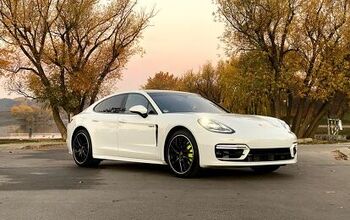2025 Porsche Panamera 4S E-Hybrid Review: The Price of Progress

The 2025 Porsche Panamera 4S E-Hybrid is a story of opposites.
The golden body is hardly subtle but the plug-in hybrid powertrain sure is, especially with the improvements to range this year. It’s a practical setup in an unpractical shape.
And yet after spending a week with this sleek sedan, I ended up liking it far more than the Cayenne S E-Hybrid I drove last year, despite the shared powertrain. Why? Because the blend of abilities—comfort, engagement, an all-encompassing sense of occasion—is where this plug-in Panamera truly shines.
2025 Porsche Panamera 4S E-Hybrid Review Quick Take
With more electric range and even better integration, the 2025 Porsche Panamera 4S E-Hybrid is a wicked all-rounder for those who think a new M5 is just too gauche.
What’s New for 2025:
The Panamera lineup got a substantial refresh last year, and we drove the “entry-level” Panamera 4 to get a feel for it. It’s a familiar story: updated looks inside and out, improved tech, and incremental power bumps. So far, so Porsche.
The 4S E-Hybrid took a year off, coming back in a slightly different format. The V6 now puts out the same power as the base model: 348 horsepower and 368 pound-feet of torque, which is actually 86 and 37 less than before, respectively. A more powerful electric motor, drawing power from a larger 25.9-kilowatt-hour (gross) battery pack, puts combined system power at 536 hp and 553 lb-ft; just 17 hp less than 2023, and the same torque.
Exterior Style:
Porsche calls this a third generation of Panamera, but in reality it’s a substantial facelift. While none of the basic measurements change, the look is altogether sharper. The headlights sweep back into a more defined point on the outer edge, framing an upright nose with larger air intakes, including a mail-slot just above the license plate. While the flanks are basically untouched, the rear now features a single-height full-width light treatment, bringing the Panamera in-line with the rest of the family.
It’s only after spending significant time in person with the new shape that the changes start to become obvious. It’s modern, aggressive without being over the top, and yes, even elegant—not something that could have been said about the original Panamera. The body-color badging and classic multi-spoke wheels are note-perfect additions. Take note, other brands: this is how you do black on wheels.
2025 Porsche Panamera 4S E-Hybrid Review: All the Details
Powertrain and Fuel Economy:
The rebalancing of gas and electric power is an interesting choice. When limited to only the V6—say, when keeping the system in E-Hold mode to maintain a charge level—the Panamera is moderately quick by 2025 standards. The six-pot is a keen revver, and the eight-speed PDK as quick and responsive as ever. There’s even a good soundtrack, at least as far as V6s—the least melodic piston configuration, in my not-so-humble opinion—go.
Mix in the electric quotient and the pace understandably picks up. There’s ample power everywhere with zero wait time, like getting to skip the line at the roller coaster. It’s assertive but not overwhelming.
Now switch off the gas motor by switching to electric mode, or just not being so greedy with the right pedal. The electric motor’s 187 horsepower and 331 pound-feet of torque is enough to push this hefty four-door down the road without ever needing to wake up its internal combustion neighbor. It will work solo right to any legal road speed in North America too, and should the gas engine chime in, it does it smoothly. North America doesn't have an official range, but I found somewhere between 30 and 40 miles (48 to 64 kilometers) wholly doable.
Handling and Drivability:
The big news for the Panamera’s traditionally sharp handling is the addition of the standard-fit two-chamber air suspension. The E-hybrid models also have the option of Porsche Active Ride, which fits each corner with an electrically-powered hydraulic pump, made possible by the updated 400-volt architecture of the powertrain. (This is similar to the system found on the refreshed Taycan, as well.)
This is real next-level stuff, with enough power harnessed within the system to not just adjust dampening, but literally lift wheels up in preparation for big bumps or extend them for dips—and lean into corners. Left in the default drive mode it’s almost spooky how flat and composed the Panamera is through twisties. Switch over to Sport or Sport Plus and the Panamera actually allows for slightly more body roll, for a more natural feeling. Regardless of mode, drivers can enjoy the same sharp, precise steering feel Porsche does so well, and the optional rear-steer works in a way that only enhances the agility. An over 5,000-pound curb weight? I know that’s technically true, but the Panamera never feels it.
Ride Quality and Comfort:
The other side of Porsche Active Ride is that the big sedan is preternaturally smooth in everyday driving. Rolling on the big 21-inch alloys wrapped in stiff winter rubber, The Panamera was in its element turning long distances into short ones. With little wind noise and only the meanest frost-heaved bits of road eliciting any noise from underneath the floor, the Panamera is peaceful. Which is an admittedly strange thing to say about a Porsche.
Comfort is excellent, as those low-mounted seats provide plenty of adjustment for a pitch-perfect driving position. And the Pepita print? Chef’s kiss right there. This tester has the 2+1 second-row setup; I wouldn’t recommend sticking three adults back there, but two will find good head- and legroom even with that tapering roofline.
Interior Style and Quality:
The Panamera’s cabin is now almost indistinguishable from that of the Cayenne. Much of that is good: there are useful physical controls right where one would want them, and plenty of Alcantara, or metal to touch. This is the leather-free interior, but the only people likely to know are those who’ve peeped the spec sheet. I still don’t love the amount of piano black infecting the center console; with the combination of touch controls, Porsche is guaranteeing smudges.
Beyond the looks, there is that bank-vault feel of solidity to the the doors and the thunk of them closing. Now soft-close is standard too, should you want a stealthier exit.
Tech and Safety:
Porsche’s infotainment system is notably sparse against the likes of maximalist BMW or extravagant Mercedes-Benz. Flash isn’t really Stuttgart’s thing, even with gold cars. This latest version has speedy responses and slick Apple CarPlay integration, and the tiled menus are super-simple to navigate. This tester has the optional passenger screen too, which essentially mirrors the central screen. No, I don’t understand it either. The digital instrument panel takes some getting used to, but once familiar it too offers plenty of available information with minimal fuss.
Porsche’s safety suite has become better over the years, though naturally that comes with added costs. The InnoDrive adaptive cruise control for example, while excellent at lane discipline, isn’t appreciably better than some of the setups found for free in mainstream models—posted speed limit integration aside. Porsche’s oddly fish-eyed backup camera still makes judging tight spots tougher than it needs to be.
Value Dollars and Sense:
This tester skips out on some notable luxury features like massaging seats, or functional ones like night vision or the sport package, which bundles the rear-axle steering with a sport exhaust and Porsche Torque Vectoring Plus. Even still, the sticker here is $161,760 ($184,520 CAD) including destination, comfortably more than the BMW M5. As much as I like it, based on the $7,390 ($8,150 CAD) sticker alone I’d have to think twice about the trick Porsche Active Ride, knowing that even the base car rides with poise.
Final Thoughts: 2025 Porsche Panamera 4S E-Hybrid Review
Porsches being pricey is hardly news. Accepting that, the 2025 Porsche Panamera 4S E-Hybrid wormed its way into my heart during our week together. The flexible and efficient powertrain paired with a chassis capable of pampering or engaging depending on the driver’s desires is a potent mix. And here in 2025, the added refinement (and rarity) of the car shape compared to an SUV makes this all the more appealing.
Become an AutoGuide insider. Get the latest from the automotive world first by subscribing to our newsletter here.
Category | 2025 Porsche Panamera 4S E-Hybrid |
|---|---|
Powertrain | 9 / 10 |
Efficiency | 9 / 10 |
Handling and Drivability | 9 / 10 |
Passenger Comfort | 9 / 10 |
Ride Quality | 4 / 5 |
Exterior Style | 4 / 5 |
Interior Style and Quality | 8 / 10 |
Infotainment | 7 / 10 |
Cargo Capacity and Towing | 3 / 5 |
Safety | 4 / 5 |
Value | 6 / 10 |
Emotional Appeal | 8 / 10 |
TOTAL | 80 / 100 |
Pros | Cons |
|---|---|
Flexible powertrain | Less power than before |
Porsche Active Ride is witchcraft | And witchcraft is expensive |
Pepita seats! | Piano black! |

Kyle began his automotive obsession before he even started school, courtesy of a remote control Porsche and various LEGO sets. He later studied advertising and graphic design at Humber College, which led him to writing about cars (both real and digital). He is now a proud member of the Automobile Journalists Association of Canada (AJAC), where he was the Journalist of the Year runner-up for 2021.
More by Kyle Patrick









































Comments
Join the conversation
Pick up an SQ7 or RSQ8, save $25k to $45k, have a better looking vehicle, better soundtrack, equivalent or better performance and more storage space. No true porschephile is clamoring for this hybrid lineup which would use 33% of its e charge to go to the grocery store and back and barely alters CO2 emissions, if that is something concerning. If this was a working strategy, Panamera sales wouldn't be 50% lower than they were 15 years ago.